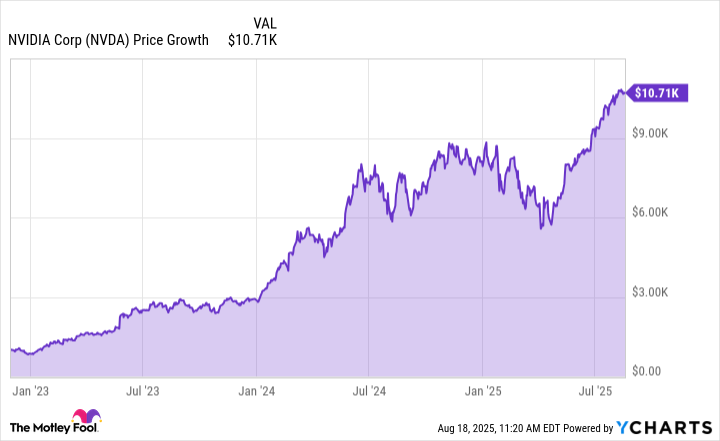Over the last few years, the stock market has experienced a profound generational shift, largely driven by the rise of the artificial intelligence (AI) revolution.
I like to think of Nov. 30, 2022, as the unofficial dawn of the AI boom. Why? That was the day OpenAI commercially released ChatGPT.
Since then, the S&P 500 and Nasdaq Composite have climbed to new highs on multiple occasions. Businesses across nearly every major sector have poured billions of dollars into AI-powered chips, software, and services, while next-generation applications -- from self-driving cars to humanoid robots -- promise to transform daily life and unlock unprecedented efficiencies.
The AI ecosystem is like a boiling cauldron of innovation, brimming with too many ingredients to track at one time. Yet one constant has always managed to rise to the top of this mix: semiconductor behemoth Nvidia (NVDA 0.35%).
Let's explore just how much a modest investment of $1,000 in Nvidia stock at the time of ChatGPT's launch would be worth today. More importantly, I'll discuss why the stock could still be worth holding despite its already historical performance.

NASDAQ: NVDA
Key Data Points
How has Nvidia stock performed since ChatGPT's launch?
When ChatGPT made its debut in late 2022, Nvidia's market cap hovered around $345 billion. Fast forward to today, and the company is valued at an astonishing $4.4 trillion -- making Nvidia the most valuable company in the world.
To put this into perspective, consider the chart above. A $1,000 investment in Nvidia stock at the time of ChatGPT's launch would now be worth roughly $10,700 -- nearly a 10x return in less than three years. On an annualized basis, this translates into an average return of 139% per year.
Are returns of this magnitude typical?
Over the last century, the compound annual growth rate (CAGR) of the S&P 500 index -- inclusive of dividend reinvestment and adjusted for inflation -- has averaged about 6.9%.
By comparison, Nvidia's joyride over the last few years not only dwarfs the long-run performance of the S&P 500, but it also stands out as an anomaly of historic proportions.
Of course, returns of this magnitude are anything but typical. Yet, there remain several compelling reasons to stay optimistic that Nvidia stock could continue climbing -- fueled by rising investment in AI infrastructure, continued robust demand for graphics processing units (GPUs), and expanding opportunities in new industries.

Image source: Getty Images.
Keep a long-term investing mindset
Following ChatGPT's debut, a wave of competing large language models (LLMs) has entered the market -- including Gemini from Alphabet, Anthropic (closely integrated with Amazon), xAI's Grok, and Perplexity.
More LLMs inevitably means more competition and a greater demand for compute power. This surge translates directly into rising AI infrastructure spending from tech hyperscalers -- many of which rank among Nvidia's largest customers.
Beyond the private sector, Nvidia also has enormous potential when it comes to sovereign investment in AI ecosystems. The company plays a central role in Project Stargate, a $500 billion initiative led by Oracle, OpenAI, and SoftBank, which aims to supercharge U.S.-based AI infrastructure and systems domestically over the coming years.
Internationally, Nvidia is becoming equally indispensable. The company is deeply involved in data center buildouts across the Middle East and recently secured an agreement with the Trump Administration that allows it to continue conducting business in China -- a market that CEO Jensen Huang estimates to be worth $50 billion on its own.
Meanwhile, emerging business opportunities in autonomous driving and robotics have yet to fully scale commercially. While neither industry is meaningfully moving the financial needle today, both represent massive long-term upside for Nvidia.
It's difficult to predict with any certainty whether Nvidia stock will 10x again from its current levels. What is clear, however, is that Nvidia remains firmly entrenched as a technological backbone for AI infrastructure. For that reason, I remain bullish on Nvidia's long-term growth prospects and see further gains ahead for the chip king.






